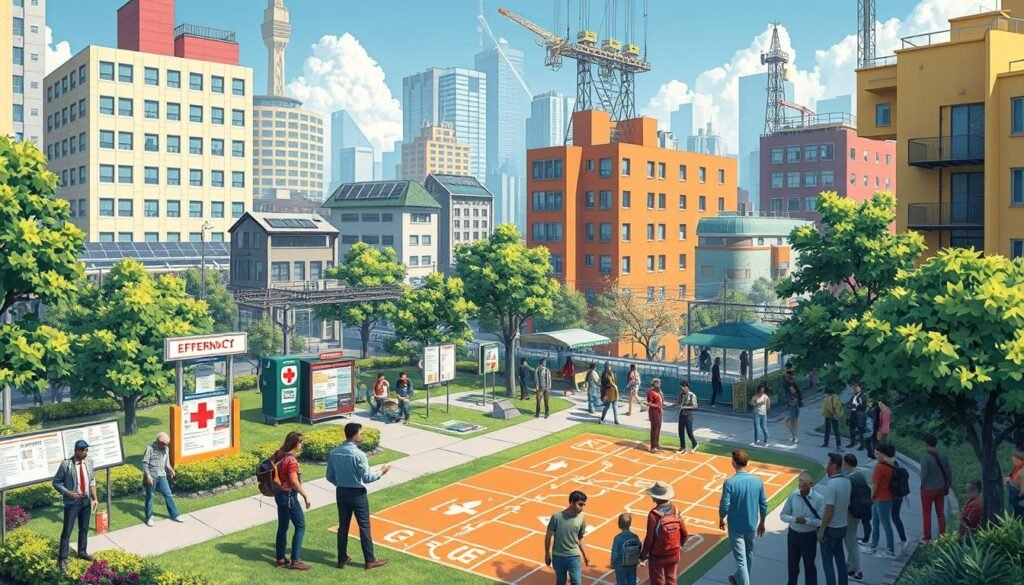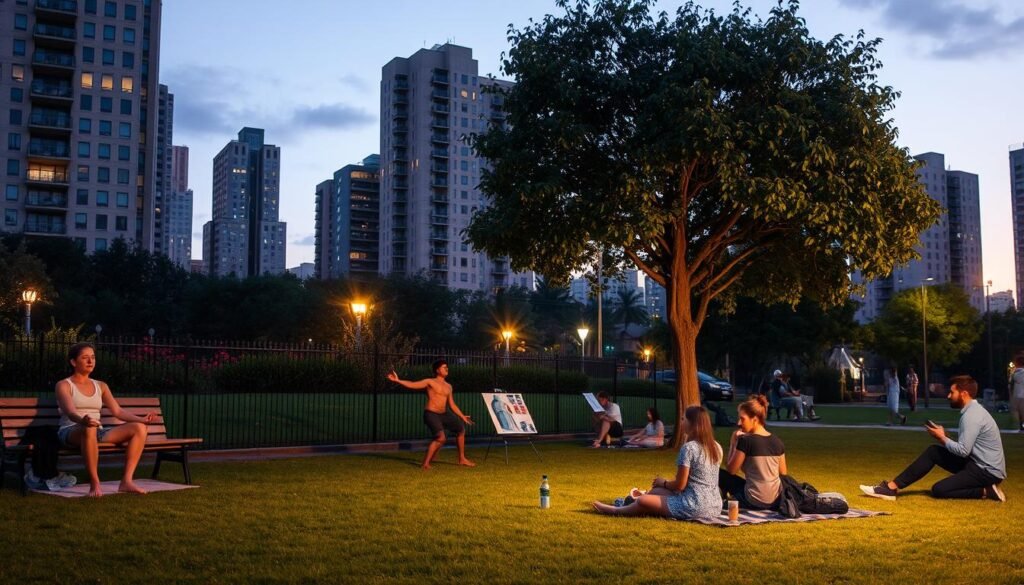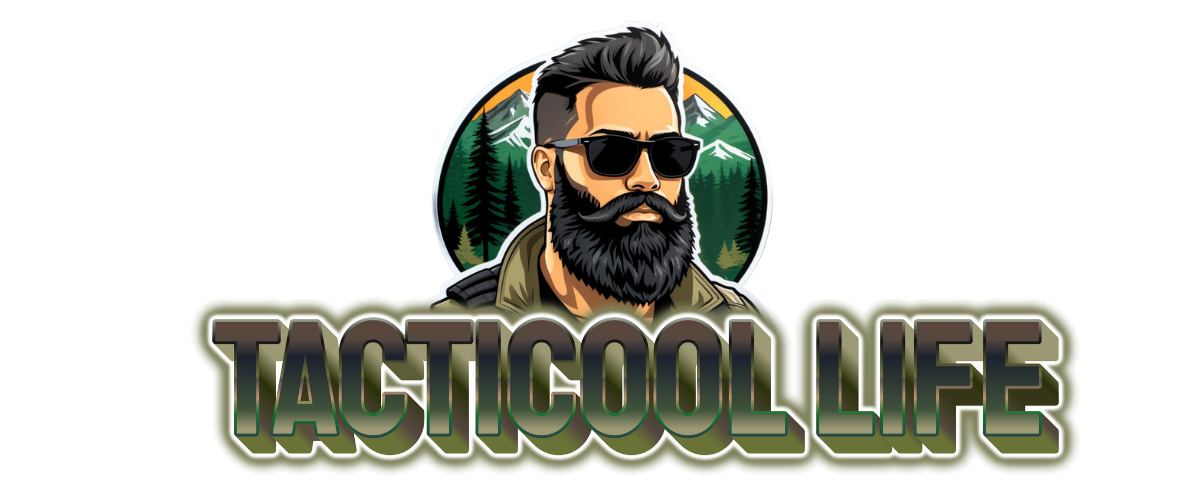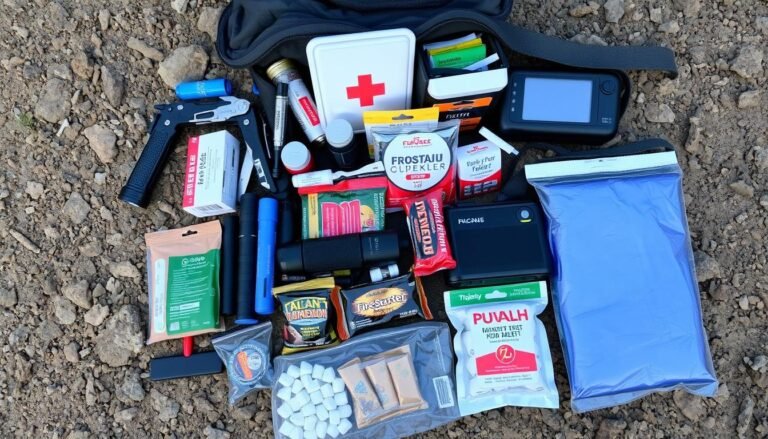More than 80% of Americans live in cities. This shows how vital it is to know how to survive in urban areas. My time in the US Army Special Operations taught me the importance of being ready for emergencies in cities. I’ve put together a detailed guide to help you stay safe and independent in the city.
We’ll explore how to not just survive but thrive in cities. We’ll cover essential skills and how to set up your survival kit for city life. Whether you’re a seasoned city person or new to the urban scene, learning these skills is key to staying safe.
Key Takeaways
- Over four-fifths of the American population confronts the realities of urban living daily, necessitating a set of specialized survival skills.
- This guide takes insights from elite military training to provide a robust city survival guide for everyday urban scenarios.
- Emergency preparedness in urban areas encompasses a wide range of skills, from situational awareness to resource management.
- Personal safety and self-sufficiency lie at the heart of urban survival strategies.
- An effectively assembled urban survival kit can be a lifesaver during unexpected city emergencies.
Understanding the Challenges of Urban Survival
Surviving in a city is different from surviving in the wilderness. In cities, we face unique challenges like crowded spaces and limited natural resources. These make it hard to apply traditional survival strategies.
Urban survival strategies and emergency preparedness need to be specially designed. They must account for the city’s dense population and complex infrastructure.
The Dynamics of City Environments
City environments are fast-paced and structured differently than nature. They are filled with residential, commercial, and industrial areas. Each area presents its own survival challenges.
It’s important to learn how to move through these areas effectively. This knowledge is key for surviving in a city.
Common Urban Threats and How to Recognize Them
Urban areas face threats like crime, pollution, and infrastructure failures. Being able to spot these dangers early is crucial. It helps in preparing for emergencies.
Stay alert to unusual activities and know your city’s disaster-prone zones. Keeping up with local news is also important. These steps help in preparing for emergencies.
Adapting Survival Skills to an Urban Setting
Surviving in a city requires being aware of your surroundings. You need to find safe places quickly and get resources in new ways. This shift from traditional survival methods shows the importance of being adaptable and creative.
Adapting to the city’s demands is essential for survival. It highlights the need for personal flexibility and innovation.
Building Your Urban Survival Mindset
Developing a strong survival mindset is key to being ready for urban disasters. It’s about understanding mental preparedness, flexibility, and resilience. These are crucial for handling emergencies in crowded cities.
Mental strength in urban survival is more than just being ready. It’s about having an adaptable mindset that keeps you calm and clear-headed under pressure. Building this mindset is like training a muscle; it gets stronger with time and effort.
Flexibility in thinking lets you quickly change your plans when conditions change. This is a vital skill during unexpected disasters. Resilience helps you recover from setbacks, letting you keep going even when things get tough. Together, flexibility and resilience are the core of effective urban survival strategies.
Resilience is not just the ability to survive, but to thrive in the face of adversity.
Also, knowing how urban environments affect us can improve your survival plans. The density, anonymity, and constant noise of cities can influence how we react in emergencies. Being aware of these factors helps tailor your urban disaster preparedness. This ensures you’re ready both physically and mentally to face crises.
| Element | Importance | Impact |
|---|---|---|
| Mental Preparedness | Foundational | Enables effective response to emergencies |
| Flexibility | Crucial | Allows adaptation to rapidly changing scenarios |
| Resilience | Essential | Facilitates recovery and continuity post-crisis |
| Psychological Adaptation | Important | Enhances overall survival strategies in urban settings |
To build a strong urban survival mindset, include these elements in your training and drills. By being mentally prepared and resilient, you can effectively manage and overcome urban challenges.
Survival Tips for Urban Environments
Surviving in the city needs sharp awareness, peace-making skills, and quick thinking. I’ll share key city survival tips. These include staying alert, solving problems peacefully, and moving through crowds without trouble.
Developing Situational Awareness
Spotting dangers early is crucial in the city. Always watch your surroundings. Look for exits, notice odd behaviors, and listen for strange sounds. This helps you act fast before others notice a threat.
De-escalation Techniques in Urban Conflicts
When a conflict starts, use de-escalation to avoid it getting worse. Speak calmly, show no threat, and seek peace. Showing you want peace often makes others calm down too.
Navigating Crowds Safely and Efficiently
Getting through crowds safely needs a plan. Stay on the edges, know where you’re going, and have backup routes. This helps you avoid trouble and get out fast if needed.
| Strategy | In Crowds | In Conflicts |
|---|---|---|
| Positioning | Stick to peripheries | Keep an open path to exit |
| Awareness | Watch for erratic movements | Listen to tone of voice |
| Communication | Non-verbal cues | Calm, clear verbal responses |
Mastering these urban survival skills means being ready, sharp, and calm. These abilities help you face daily city challenges and emergencies.
Customizing Your Urban Survival Kit Essentials
When you’re making your urban survival kit, focus on what city life needs. The right gear can mean the difference between being ready and being caught off guard. I’ll show you how to pick items that are useful, light, and do more than one thing.
Picking the Right Tools for City Survival
Choosing the right tools means looking for ones that are versatile and efficient. A multi-tool is better than carrying many tools because it saves space and is cheaper. Must-haves include a strong flashlight, a durable knife, and a reliable fire starter.
Lightweight and Multipurpose Gear Choices
The idea ‘less is more’ is especially true for urban survival kits. Choose items that can do many things, like a paracord bracelet that can be a tourniquet, fishing line, or a tie-down for a shelter. Clothes and gear that are light but strong help you move freely while staying safe and useful.
Portable Emergency Supplies for Urban Disasters
In cities, you need emergency supplies that are easy to carry and can be used quickly. You’ll need a small first-aid kit, long-lasting emergency food, and a way to purify water. These items help you meet your basic needs when services are not available.
| Item | Weight | Utility | Compactness |
|---|---|---|---|
| Multipurpose Tool | Light | High | Very High |
| LED Flashlight | Light | High | High |
| First-Aid Kit | Medium | Essential | High |
| Emergency Food Rations | Medium | High | Medium |
| Water Purification System | Light | Essential | High |
Securing Shelter and Safety in Urban Landscapes
I’ve learned a lot about survival skills in the city. Finding safe shelters is key. It’s crucial when facing disasters or losing your home. Here, I’ll share ways to find or make shelters in the city.
- Identifying Potential Shelter Zones: Safe shelter zones are key in urban survival. Look for buildings that are strong and not often visited. These places should also be safe from the weather and people.
- Using Abandoned Vehicles: An old car can be a quick shelter. They hide you and can be locked for safety at night.
- Repurposing Derelict Buildings: With care, old buildings can become shelters. Make sure to lock the doors to keep others out.
Learning these survival tips can help you stay safe in cities. These survival skills in the city prepare you for emergencies. They also make you feel more ready for unexpected situations.
Essential Urban Survival Techniques
Learning urban survival techniques is key for city living. You’ll need to know how to find and purify water, do basic first-aid, and navigate without tech. These skills are vital for staying safe and self-sufficient in cities.
Finding and Purifying Water in an Urban Environment
Finding clean water in cities can be tough, especially in emergencies. Look for public fountains, park water bodies, or HVAC moisture. Purifying this water is next. Boiling is simple, but portable filters or tablets work too.
Basic First Aid and Self-Care Skills
Knowing basic first aid is crucial. Learn CPR, wound care, and how to handle fractures or sprains. Keep a first aid kit ready with bandages, antiseptics, pain relievers, and gloves. Update your kit often to be ready for injuries.
Navigating Without GPS During Technology Failures
Knowing how to navigate without GPS is very useful. Get to know major landmarks, use paper maps, and learn to find directions with the sun. These tips will help you stay oriented and make smart choices when tech fails.
| Technique | Tools Needed | Benefit |
|---|---|---|
| Water Purification | Boil, Filters, Tablets | Access to clean and safe drinking water |
| Basic First Aid | First Aid Kit | Ability to handle common injuries |
| Navigating without GPS | Physical maps, Compass | Confidence in movement despite tech failures |
Food Sources and Urban Foraging
In the city, finding food can be tough. But urban foraging offers a way to find food in unexpected places. It’s important to know where to look and how to stay safe while foraging.
Learning about edible plants in the city can help a lot. Parks and community gardens are full of dandelions, wild onions, and berries. These can be great sources of food.
But foraging in the city has its own challenges. You have to worry about pollution and pesticides. That’s why I stress the importance of knowing what plants are safe to eat.
| Plant | Locations Commonly Found | Usage |
|---|---|---|
| Dandelion | Parks, lawns, roadside | Salads, tea |
| Wild Onion | Meadows, forest edges | Cooked dishes, garnishes |
| Burdock | Waste areas, gardens | Roots and leaves in soups |
Teaching about urban foraging helps people survive and connect with their city. It teaches us to use what’s available and promotes sustainability. These are key skills for surviving in the city.
Urban Survival Tactics During Power Outages
Power outages in cities can be tough. It’s key to know how to survive in the city when the lights go out. Here are some tips to stay safe and strong when the power fails.
Alternative Energy Solutions for the City Dweller
In cities, we rely a lot on technology. So, finding other ways to get power is important. Portable solar panels and hand-crank generators can help keep things running. A solar power bank is great for keeping phones charged, so you can stay in touch.
Security Measures When the Lights Go Out
Without lights, cities can feel less safe. To stay safe, use motion sensor lights that run on batteries. They light up your space and scare off intruders. Also, make sure to lock all doors and windows. Think about getting a battery-operated security camera too.
Preserving Food Without Electricity
Keeping food safe during a power outage is crucial. Use coolers with ice packs to keep food fresh for a few days. For longer storage, have non-perishable items like canned goods and dried foods. Remember to check these items often to keep them good.
Using these survival tips can help you handle power outages better. Always have an emergency kit ready. Stay calm and ready to face the challenges of city life when the power goes out.
Urban Disaster Preparedness: Action Plans
In the heart of urban disaster preparedness, creating actionable plans can significantly enhance safety and reduce chaos. Here, I delve into the critical components required to effectively prepare for urban disasters.
Creating an Evacuation Strategy
Developing a sound evacuation plan is paramount in emergency preparedness in cities. This involves mapping out escape routes from your home and workplace to designated safe zones. It’s crucial to practice these routes to ensure everyone involved understands them well.
Communication Plans When Conventional Methods Fail
Should standard communication channels fail, having alternative methods in place is vital for maintaining contact. Text messages, emergency broadcast stations, and satellite communications can be life-saving when cell phone towers and internet services are down during urban emergencies.

Gathering Critical Information and Resources
Part of effective preparedness involves compiling critical information and resources beforehand. This includes local emergency numbers, contact information for nearby emergency centers, and updated personal documents. Stocking up on essential supplies like food, water, medications, and batteries is also crucial.
By enhancing our strategies to prepare for urban disasters, we ensure that we are not only able to respond efficiently but also mitigate much of the risks associated with urban catastrophes.
Self-Defense Skills for Surviving in the Concrete Jungle
As cities get more crowded and unpredictable, knowing self-defense skills is key. It’s not just about being aware; it’s about being proactive. I’ll cover the practical self-defense moves for tight spots and crowded places. Plus, the laws everyone living in the city should know.
Learning the basics of self-defense skills can really boost your safety in the city. It helps in handling aggressive situations or unexpected attacks. Knowing your local self-defense laws is also vital. It makes sure your actions are both safe and legal.
| Technique | Explanation | Practical Scenario |
|---|---|---|
| Strike to Key Points | Targeting areas like eyes, nose, or throat to incapacitate the attacker temporarily. | An assailant confronts you in a parking lot late at night. |
| Escape and Evade | Techniques focused on quick exit strategies to avoid physical confrontation. | You notice suspicious behavior on a subway and need to exit safely. |
| Use of Improvised Weapons | Utilizing everyday objects like pens or keys as defensive tools. | An aggressive dog approaches and you use your backpack to shield yourself. |
| Vocal Assertiveness | Using a firm and loud voice to attract attention or dissuade an aggressor. | A suspicious person is following you; loudly declaring your awareness to alert passersby. |
These self-defense skills focus on both physical and mental readiness. They teach you to act quickly and decisively. The main goal is to stay safe and avoid harm. By learning these skills, we make our cities safer for everyone.
Blending In: The Art of Urban Camouflage and Movement
Stealth is as important as strength in the city. Learning urban camouflage means blending into the city to stay hidden. It’s about moving without being seen or heard during emergencies.
Using Urban Terrain to Your Advantage
Knowing your surroundings is key in the city. Alleys, stairwells, and shadows can help you stay hidden. This skill is crucial for staying safe and unseen.
Low-Profile Apparel and Gear
Choosing the right gear is vital for staying hidden. Wear colors and patterns that match the city, like grays and blacks. Also, pick gear that’s useful but doesn’t draw attention. Tools that do many things at once are best for city survival.
Moving Unseen and Heard in a Busy City
The city’s noise can help you move quietly. Use loud sounds like trucks or trains to cover your steps. Also, stay relaxed but alert to avoid standing out. This makes you seem like just another person rushing to get somewhere.
Mental Health and Coping Mechanisms
Having an urban survival mindset means focusing on both physical and mental health. The stress of city life can really affect your mental well-being. It’s key to find ways to stay mentally strong when things get tough.

Knowing when you’re stressed and how to handle it is crucial. Coping mechanisms are vital here. They can be simple, like deep breathing, or more complex, like changing how you think.
- Regular physical activity to boost mood and reduce anxiety
- Keeping a journal to process thoughts and emotions
- Establishing a routine to provide stability
- Practicing mindfulness and meditation to stay grounded
Adding these habits to your daily life boosts your urban survival mindset. It also helps you deal with emergencies better. Being emotionally strong can make you more decisive and effective under pressure.
| Technique | Description | Benefits |
|---|---|---|
| Mindfulness | Focuses on being intensely aware of what you’re sensing and feeling at the moment. | Reduces stress, enhances focus |
| Cognitive Restructuring | Identifies and challenges negative thought patterns, replacing them with more positive ones. | Improves mood, reduces anxiety |
| Physical Exercise | Engages in regular physical activity. | Increases endorphins, improves sleep quality |
| Strategic Disengagement | Temporarily stepping back from stressful situations to gain perspective. | Prevents burnout, enhances problem-solving |
Looking into these coping mechanisms helps you navigate the city better. It’s not just about physical skills but also having a strong mind. Every challenge you face and overcome makes your mindset stronger. This shows that mental toughness is just as important as physical strength in surviving the city.
Networking with Other Urban Survivors
In the busy city, strong community ties are key to survival. By networking, we can do more than just survive. We can share resources and help each other, making us stronger against any challenge.
Building a Community Support System
Starting a local group is easy. Just gather people to share skills and resources. Regular meet-ups for training keep everyone ready and connected.
Sharing Resources and Knowledge
Working together, we can use everyone’s talents. This means having skills like first aid and mechanical repair. These are crucial in the city’s changing environment.
Forming Alliances for Mutual Assistance
Building alliances makes us safer and more ready to face challenges. Together, we can handle disasters or social issues better. This makes our community stronger.
Good communication and regular meetings are key. They help us survive and build strong community bonds. This way, we’re ready for anything nature or humans throw our way.
| Resource | Contributor | Benefit |
|---|---|---|
| Mechanical Tools | Local Mechanics | Vehicle and machinery maintenance during emergencies |
| Medical Supplies | Health Professionals | Improved readiness for medical emergencies |
| Food Supplies | Community Gardens | Sustainable food source during shortages |
| Communication Equipment | Technology Experts | Reliable means of communication during power outages |
Staying Informed: Keeping Abreast of Urban Dangers
Living in a city means it’s key to stay up-to-date with the latest news. Knowing what’s happening around you can be a lifesaver. I’ll share tips on how to keep informed, understand emergency alerts, and use tech wisely during crises.
Maintaining Access to Information Sources
Having access to reliable info is vital for city survival. Make sure you can always get to news and updates. This includes keeping your devices charged and setting up alerts from trusted sources.
Understanding Emergency Alerts and Warnings
Emergency alerts are crucial for city safety. They tell you about dangers ahead. Learn about the different alerts and what they mean. This includes weather warnings and other alerts from systems like the Emergency Alert System (EAS).
Using Tech to Your Advantage in Crisis Situations
Today, tech is a must-have for survival. Use apps for local crime and weather updates. Also, online maps and forums can give you real-time info during emergencies.
| Technology Tool | Benefit | Usage Tip |
|---|---|---|
| Emergency Alert Apps | Real-time notifications | Customize alerts based on your location and the type of emergencies that affect your area. |
| Offline Maps | Navigation without internet | Download maps of your area so they can be accessed without cellular data. |
| Social Media | Community-based updates | Follow local safety, neighborhood watch, and governmental pages for quick updates during emergencies. |
Conclusion
We’ve explored the world of urban preparedness together. I’ve shared many survival tips for urban environments with you. These tips are not just suggestions, but essential tools for staying safe in the city.
They cover everything from staying alert to handling tech failures. This knowledge is key to your city emergency survival guide.
Urban survival is more than just personal safety. It’s about being strong for your community too. I’ve learned that being ready doesn’t mean being scared. It means being powerful.
Every step we take to get ready makes us stronger. We build better kits, find safe places, and connect with others. This way, we’re ready for anything life brings.
I want you to keep learning, practicing, and staying in touch with others who care about survival. Walk your city streets with confidence. Know you can handle any challenge that comes your way.

